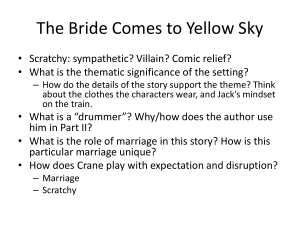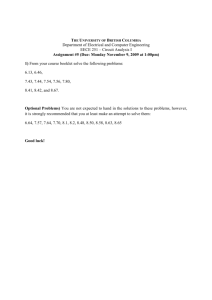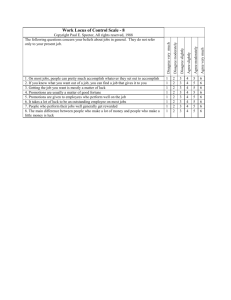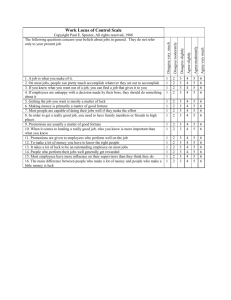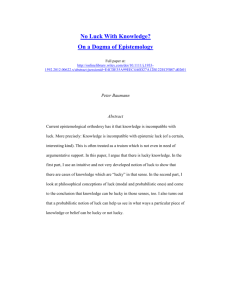Answers to short answer Questions
advertisement
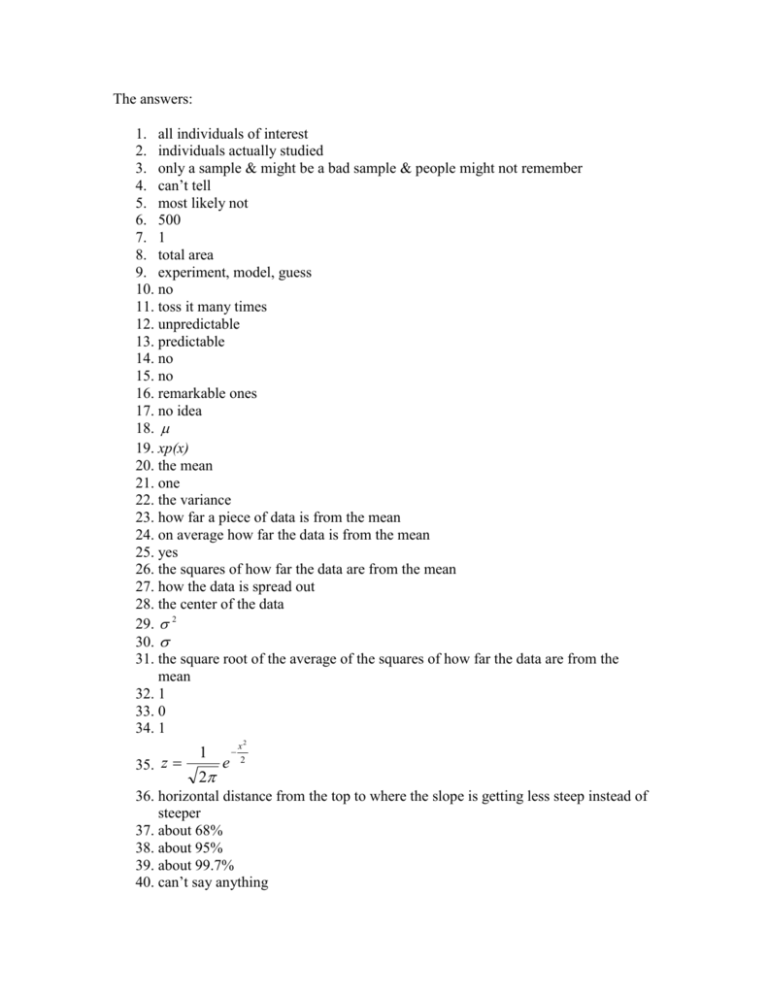
The answers: 1. all individuals of interest 2. individuals actually studied 3. only a sample & might be a bad sample & people might not remember 4. can’t tell 5. most likely not 6. 500 7. 1 8. total area 9. experiment, model, guess 10. no 11. toss it many times 12. unpredictable 13. predictable 14. no 15. no 16. remarkable ones 17. no idea 18. 19. xp(x) 20. the mean 21. one 22. the variance 23. how far a piece of data is from the mean 24. on average how far the data is from the mean 25. yes 26. the squares of how far the data are from the mean 27. how the data is spread out 28. the center of the data 29. 2 30. 31. the square root of the average of the squares of how far the data are from the mean 32. 1 33. 0 34. 1 35. z 1 2 e x2 2 36. horizontal distance from the top to where the slope is getting less steep instead of steeper 37. about 68% 38. about 95% 39. about 99.7% 40. can’t say anything 41. at least 75% 42. at least 88.8% 43. normal 44. 0 45. 1 46. number that describes the population 47. number that describes a sample 48. statistic _ 49. x 50. s 51. s 2 _ 52. x 53. s 54. large 55. luck and large sample size 56. luck 57. large sample size 58. 59. n 60. not much 61. normal 62. gets closer to normal, Central Limit Theorem 63. A, standard deviation, less 64. highs and lows tend to cancel out 65. standard deviation of all the data in the population, the standard deviation of all the sample means of a certain sample size, the standard deviation of one sample 66. s and , the other one is less 67. how many standard deviations from the mean 68. how many games were both wins and at home 69. how many games were at home 70. divide by total 71. F 72. F 73. B has no affect on the chances of A 74. independent 75. P(X) 76. multiple how many choices at each step 77. n! 78. (42)(41)(40)(39)(38)(37) 6! (42)(41)(40)(39)(38)(37)/6! 79. multiplying in a tree diagram & lottery formula 80. 5.5 to 6.5 81. number of failures 82. how many ways you can get k successes in n trials 83. average number of failures 84. anecdotes 85. all the data 86. looking at all the data about child and leukemia and power lines instead of news interview of one mother with child with leukemia that happens to live near a power a line 87. a variable that affects the variables you are interested in but is not mentioned 88. child in soccer have higher school scores, but a LV is how much the parents want their kids to succeed, if they want there kids to succeed a lot then they will be more likely to put them in soccer and also do things such as to encourage them to study 89. yes 90. yes 91. no 92. no 93. assume the data are the midpoints of the ranges given 94. the under 25 has a lot more drivers 95. the y-axis does not start at 0 & who decided what the set list of groceries is 96. to understand the data 97. no, definition of child abuse could be different 98. mostly the best students in North Dakota take the SAT while in New Jersey a much higher percent take the SAT 99. there are many more drivers not drinking so they could easily have more accidents 100. no 101. Buchanan 102. a higher percent take the SAT in Colorado 103. the Southern states would be towards the bottom 104 the Southern states are mixed in well with the other states 105. r 106. 107. sum of the squares of the vertical distances from the points to the line 108. nothing 109. different result 110. nothing 111. r uses standardized values 112. 1.43 113. -1 and 1 114. smaller + - 115. no 116. linear 117. exponential & quadratic & logistic 118. yes 119. yes 120. r 121. % of the difference in y explained by the regression line on x 122. yes 123. no 124. no 125. no 126. extrapolation 127. B 128. A 129. no 130. ice cream sales & sunburns 131. lurking variable – how much the parents want their kids to succeed 132. BMI between mothers and daughters, genetic and environmental 133. Gun control laws & violent crime levels 134. yes 135. a gene that both made people addicted to nicotine and gave them lung tumors 136. the gene would have appeared coincidentally later in women(who started smoking) than men 137. how motivated a person is 138. no 139. yes 140. scatterplot of degree days and gas used to heat a house but half way through the collection of data solar panels were installed and reduced the gas bills 141. A 142. about right 143. less reliable 144. two-way table 145. a relationship that holds in each subcategory but reverses when all the data is combined 146. helicopters vs road for accident victims, helicopters do better in serious and less serious cases, but when combined the road did better 147. observational study 148. experiment 149. experiment 150. heart attacks in menopausal women with hormone replacement therapy 151. no 152. how much the women cared about their health 153. smoking, diet, wealth (wine drinkers tend to smoke less, have a better diet, and be wealthier affording better health care) 154. experiment 155. get 10 nice roses no 156. against tuff looking people, in favor of retired people, in favor of teenagers 157. F 158. ignorance & agenda 159. no 160. Ann Landers asking her readers to write in about whether they wish they didn’t have children 161. bias in favor of their points of view 162. liberal groups ambushed it 163. random 164. rarely 165. no 166. yes 167. survey by phone – people without phones are not covered 168. survey in which not all surveys are completed 169. the people not responding or not covered may be different in important ways 170. no no no in favor of the stadium no 171. yes 172. do you think we are spending too much on “welfare” vs “help for the poor” 173. do you use illegal drugs? 174. have you been to the dentist in the last 6 months? 175. a uniformed police officer asking questions about peoples’ opinion of the police department 176. has participating in our health program improved your health? 177. teacher A might be easier, students might be better in the online, luck 178. a group that gets the standard treatment 179. divide treatments at random, use a control group, use a lot of subjects 180. rarely would occur by luck 181. dummy treatment that an individual is told is the same as an actual treatment 182. remove the placebo affect, some people respond well to any treatment 183. neither the individuals nor those dealing with them directly know what treatments are given 184. doctors giving a placebo might not be as positive 185. sample size and difference 186. TV commercials with a captive audience vs how normal people watch TV 187. order of treatments might affect the results 188. helps remove the problem of one group getting better individuals by luck 189. up 190. down 191. up 192. small 193. Ha 194. no 195. 196. unknown 197. 198. type I 199. type II 200. 201. unknown 202. 203. 204. type I 205. it is true 206. the sample statistic Ho is true 207. critical values 208. table 209. test statistic 210. calculation 211. assuming Ho is true it is the chance of finding as strong or stronger evidence than we got that Ho is not true 212. right stronger true 213. less 214. small 215. no 216. no 217. decide if the lack of meeting conditions is minor or major 218. decide if the problems are minor or major 219. no 220. adults with normal vision, but using students in a psychology class 221. adults, but using students in a sociology class at a college 222. gastric freezing on ulcers 223. the gastric freezing placebo controlled 224. yes 225. remove it 226. no 227. no 228. no 229. no 230. no 231. luck 232. nothing 233. how important it is to get it right, how hard it would be to believe the result, consequences 234. no 235. go down 236. no 237. no 238. statistically practically 239. no 240. no 241. just by luck a HT will show a result that is not true 242. yes 243. the more times it is repeated the more sure you are 244. 40 8 245. 16 246. normal 247. beer 248. no 249. yes 250. 1 251. z 252. rarely 253. small 254. small differences will be statistically significant 255. Central Limit Theorem 256. round down 257. yes 258. no 259. more 260. 40 8 261. 16 262. t with 15 degrees of freedom 263. a)worse, b)better, c)better 264. Only b, c, d, f, h, i, l, m, and n are probably OK 265. Only c, d, f, h, and k are probably OK 266. shapes outliers 267. histogram or boxplot 268. histogram or boxplot 269. z 270. subtraction Y2 X2 nX nY 272. normal 273. 0 nX 271. X2 82 9 2 14 12 275. normal 276. 0 274. 82 9 2 14 12 278. p’ 279. p 280. p’ 281. divide by n 282. n n 2 283. p p pq pq 284. n n 285. normal 286. 10 277. Y2 nY s X2 sY2 s X2 s2 Y n X nY 287. .5 smaller 288. smaller 289. normal 290. .40 (.4)(.6) 291. 200 292. true p’ q’ 293. subtraction px qx pY qY 294. nx nY 295. 296. px qx nx pY qY nY p x q x pY qY nx nY p X q X pY qY nX nY p'1 q'1 p' 2 q' 2 n1 n2 p 'pool q 'pool n1 p 'pool q 'pool n2 where p 'pool x1 x2 n1 n2 297. 0 (.4)(.6) (.4)(.6) 140 120 299. normal 300. yes 301. yes 302. yes 303. no 304. no 305. 1 306. 1 307. 2 with 24 degrees of freedom 308 division 309. F with 9 degrees of freedom on the top and 7 degrees of freedom on the bottom 310. differ a lot big 311. Ho is true 312. P(R2 & C3) R2 C3 independent R2 total / grand tot C3 total / grand tot 313. 10 314. normal populations, equal variances, independent samples, SRSs 315. source & luck 316. factor error 317. variance means 318. mean variances 319. better 320. worse 321. better 322. worse 323. data is linear, normally distributed about the line, independent data, standard deviation is the same throughout the line 298. 324. yes 325. no 326. easier, less assumptions 327. waste info 328. median Sign Test
